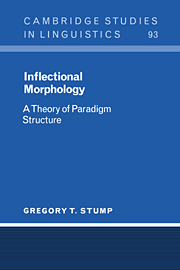1 - Inferential–realizational morphology
Published online by Cambridge University Press: 14 October 2009
Summary
Theories of inflectional morphology
In any language exhibiting inflection, each inflected word in a sentence carries a set of morphosyntactic properties; in English, for instance, the verb form am in the sentence I am sure carries the properties ‘first-person singular (Isg) subject agreement’, ‘present tense’, and ‘indicative mood’. In very many cases, an inflected word's morphosyntactic properties are associated with specific aspects of its morphology; for instance, the properties of subject agreement, tense, and mood carried by the verb form likes in the sentence She likes reading are associated with the presence of the suffix -s. In recent years, grammatical theorists have devoted considerable attention to the nature of these associations between an inflected word's morphosyntactic properties and its morphology. Nevertheless, these efforts haven't yet led to anything like a consensus in current theories of inflection.
According to LEXICAL theories of inflection, these associations are listed in the lexicon; the affix -s, for example, has a lexical entry which specifies its association with the morphosyntactic properties ‘3sg subject agreement’, ‘present tense’, and ‘indicative mood’. Theories of this sort portray the association between an inflectional marking and the set of morphosyntactic properties which it represents as being very much like the association between a lexeme's root and its grammatical and semantic properties. This conception is rejected by INFERENTIAL theories, in which the systematic formal relations between a lexeme's root and the fully inflected word forms constituting its paradigm are expressed by rules or formulas.
- Type
- Chapter
- Information
- Inflectional MorphologyA Theory of Paradigm Structure, pp. 1 - 30Publisher: Cambridge University PressPrint publication year: 2001



